Norbert Bisky
Polympsest
12 JUN until 13 JUL 2025
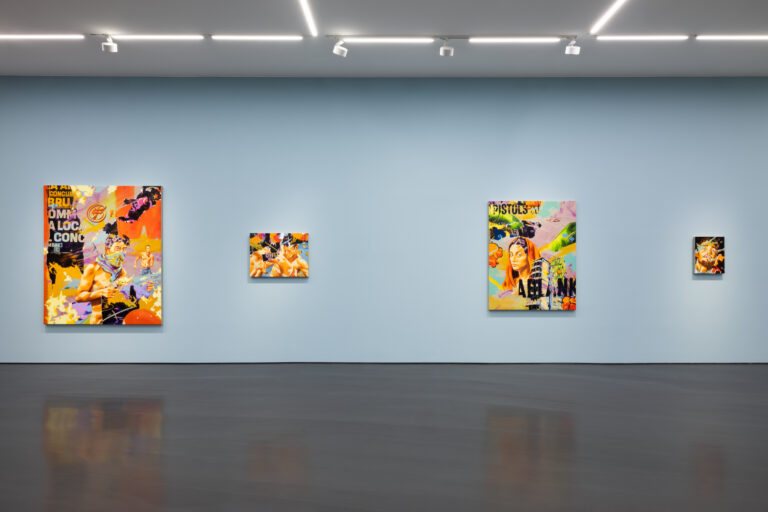
Exhibition view:
Norbert Bisky, Polympsest,
Esther Schipper Berlin, 2025
Courtesy the artist and Esther Schipper, Berlin/
Paris/Seoul
Photo © Andrea Rossetti
© Norbert Bisky / VG Bild-Kunst, Bonn 2025
Esther Schipper is pleased to announce Polympsest, Norbert Bisky’s first solo exhibition with the gallery. On view will be all new paintings and a lamp sculpture.
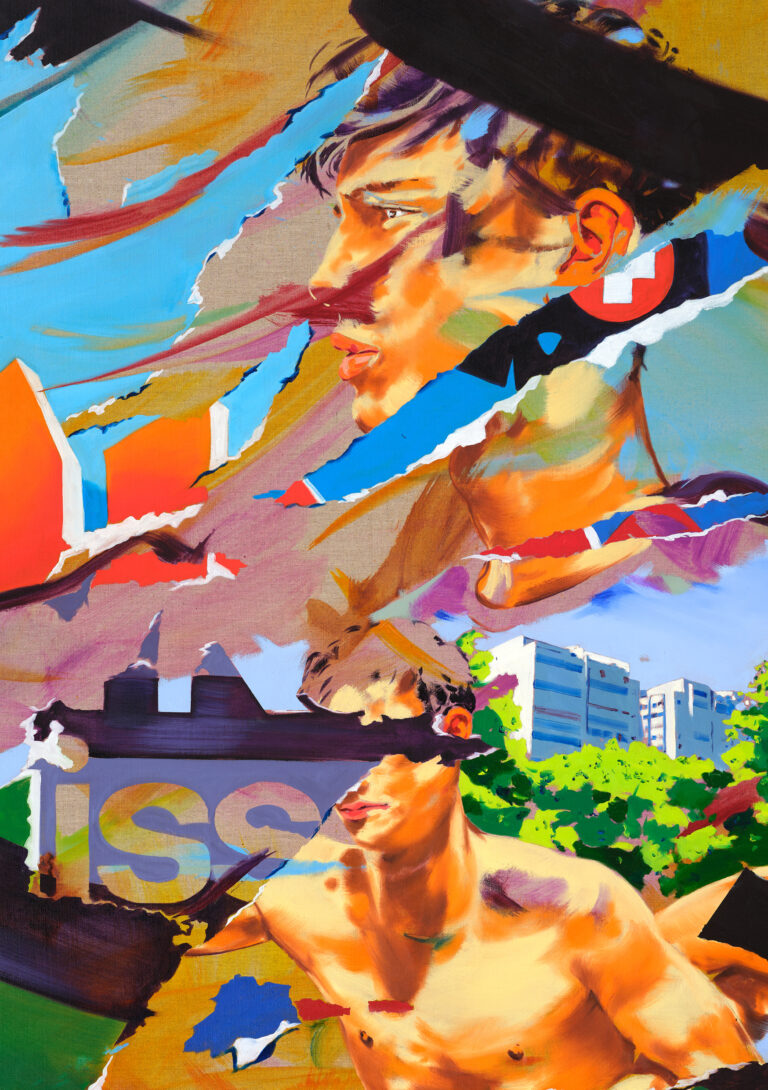
Norbert Bisky,
Berliner Allee, 2025,
oil on canvas,
150 x 120 cm (59 x 47 1/4 in) (NBI 020).
© the artist
Norbert Bisky has established a formal vocabulary in which bodies become representations of existential states. The title, Polympsest, a neologism composed from the word palimpsest and the prefix poly, already signals two main tenets of the new body of work. It emphasizes the plurality of influences and the layered iconography, which is a contemporary urban equivalent of the ancient practice of overwriting manuscripts, to which the word palimpsest originally referred.
Bisky’s figures—painted in bright and seductive colors yet fragmented, falling, untethered—have always been a symbol of the precarious nature of man in totalitarian societies and under capitalism. The new paintings provide this intuited meaning with concrete narrative underpinnings: The young men have banded together in apparent conflict in some paintings or address the spectator directly; some appear to be shouting, others are masked, holding a Molotov cocktail in their hand, or gesture a gunshot. These paintings are of the here and now: they picture landmarks of Berlin life, some of which are threatened by gentrification or urban decay. They are a wakeup call by articulating a wider sociopolitical mood and the consequences of the state of polycrisis on psyche, society, or city—as exemplified by Berlin where the artist has lived since 1981.
The state of the city, and society at large, is represented by heady mix of quotations from urban life. The streets are alive in these paintings but also in a feverish dream of change, upheaval and decay. A recurring motif of these works are tromp l’oeil-like depictions of torn posters with parts of words or single letters of text remaining. The reference to the aesthetic of the French post-World War II artists known as “affichistes” (from French affiche meaning poster) is not only formal but conceptual, pointing to the larger context of that moment in the late 1950s and 1960s. The affichistes drew on Abstract expressionist aesthetics but grew out of the radical politics of reappropriation (detournement) and urban wanderings (dérive) of the Situationist International. Comics, signs, and fragments of street art also feature in Bisky’s paintings, reiterating the hybridity of the urban environment, a living canvas of signs in constant flux.
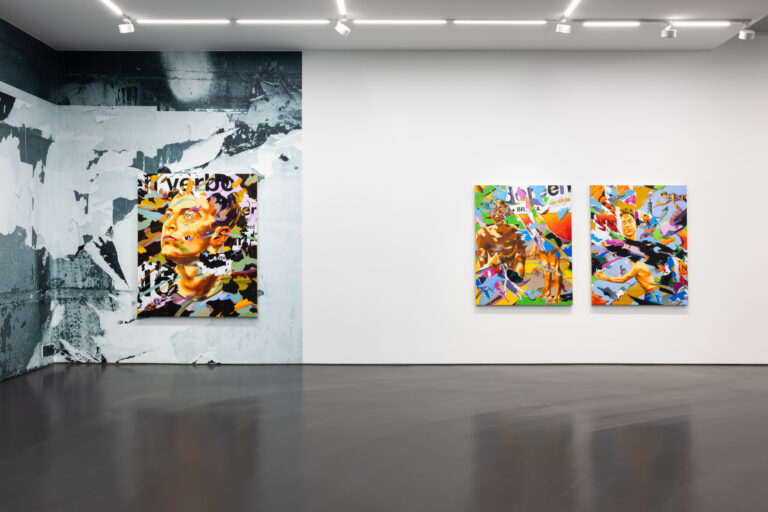
Exhibition view:
Norbert Bisky, Polympsest,
Esther Schipper Berlin, 2025
Courtesy the artist and Esther Schipper, Berlin/
Paris/Seoul
Photo © Andrea Rossetti
© Norbert Bisky / VG Bild-Kunst, Bonn 2025
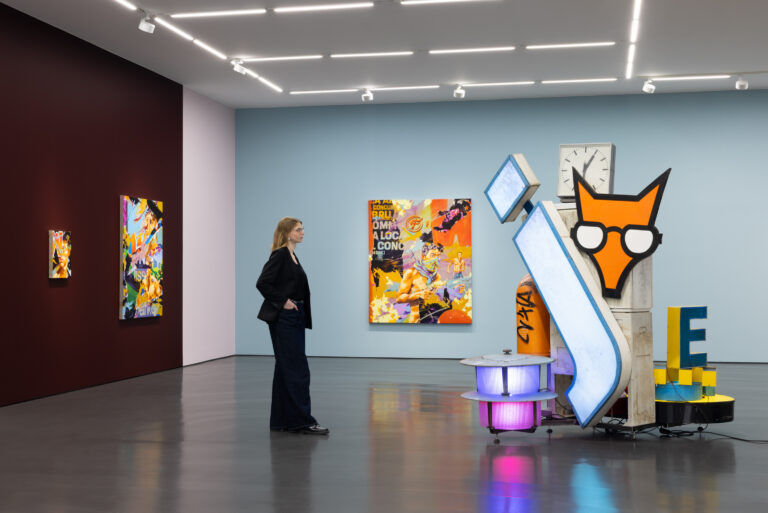
Exhibition view:
Norbert Bisky, Polympsest,
Esther Schipper Berlin, 2025
Courtesy the artist and Esther Schipper, Berlin/
Paris/Seoul
Photo © Andrea Rossetti
© Norbert Bisky / VG Bild-Kunst, Bonn 2025
Formally drawing on painting’s history and its contemporary discourse, Bisky’s works combine figurative and abstract elements. His figures are surrounded by painterly sections of thin translucent glazes applied in broad loose strokes. At times, they appear to delve into a sea of color or are partially obscured by sweeping patches. Some sections appear at first like raw canvas. A major theme of the current body work, then, is the ruin. With their deliberate play on an unfinished and fragmentary quality, the paintings evoke its history as elegiac motif in 18th and especially 19th century painting and architecture where ruins functioned as symbolic representation of the fleetingness of life and, more broadly, of civilizations.
Championing plurality over purity, the formal incorporation of a wide array of art historical and everyday life influences is understood as a political gesture at a time when personal, sexual, cultural, and political freedoms taken for granted—in the West, in Germany and Berlin—are under threat. The bright and playful aesthetic has a combative quality, not just in its narrative allusions to unrest but with its insistence on a socio-politically coded color scheme, with its purple blurs and pink, orange and baby blue defiantly celebrating an exuberant camp aesthetic. The message is clear: We need to be alert to the changes in our environments and take seriously the messages scrawled on the walls, the election posters ripped to shreds, and the slogans that threaten communities.
With its assemblage of urban fragments such as electrical boxes, trash cans, illuminated letters, doorbell panels, and streetlamps, the lamp sculpture installed at the center of the exhibition space further emphasizes the references to street life. The work was produced in collaboration with Lars Murasch.
Norbert Bisky was born 1970 in Leipzig, Germany. He studied painting at the Berlin University of the Arts in the class of Georg Baselitz; a year at the Universidad Complutense in Madrid and joined the class of Jim Dine in the Salzburg Summer Academy. He lives and works in Berlin and Andalusia.
From 2008 to 2010, Bisky was a visiting professor at the Geneva Academy of Fine Arts HEAD and from 2016 to 2018 at the Braunschweig University of Art.
Bisky’s vivid imagery has also featured in the context of performing arts. In 2013, he created the stage design for the Staatsballett Berlin’s performance of Masse, which took place in the Halle am Berghain. His work Vertigo has been permanently installed in the entrance area since May 2017. For the Stuttgart State Opera in cooperation with the Ludwigsburg Palace Festival, he directed and created the stage design for the play Die Schöne Müllerin in 2024. His series of works Colaba is part of the new collection presentation at the Staatsgalerie Stuttgart, This is Tomorrow.
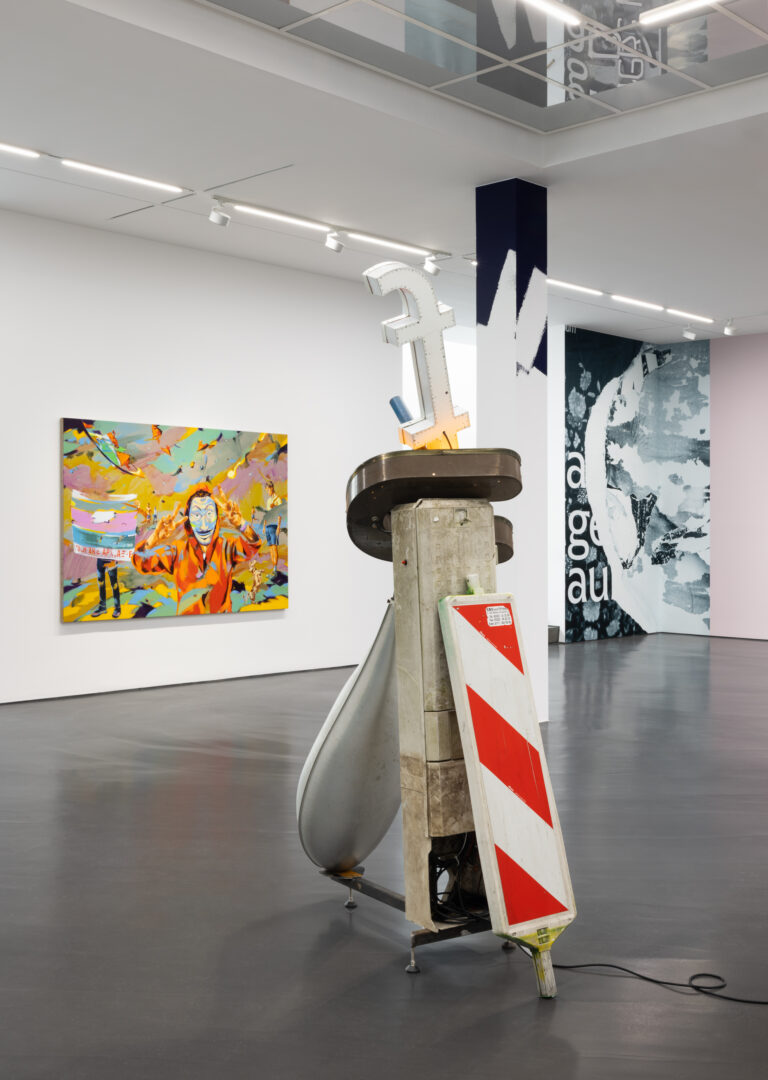
On the wall:
Norbert Bisky
Prequel, 2025
Oil on canvas
170 x 250 cm
Foreground:
Norbert Bisky
Lit f, 2025
Assemblage of found street lights, signage and
urban objects, lighting electronics
231 x 100 x 70 cm
Exhibition view:
Norbert Bisky, Polympsest,
Esther Schipper, Berlin, 2025
Courtesy the artist and Esther Schipper, Berlin/
Paris/Seoul
Photo © Andrea Rossetti
© Norbert Bisky / VG Bild-Kunst, Bonn 2025
The artist has had numerous international solo exhibitions, among them are: Walküren, Museum der Stadt Worms im Andreasstift, Worms (2024); Im Freien, Kunstverein Freunde Aktueller Kunst, Zwickau (2023); Mirror Society, SCAD Museum of Art, Savannah, Georgia (2022); DISINFOTAINMENT, G2 Kunsthalle, Leipzig (2021); Berlin Sunday, Le Confort Moderne, Poitiers (2020); Pompa, St. Matthäus-Kirche, Berlin (2019); Rant, Villa Schöningen, Potsdam (2019); Balagan, Bötzow, Berlin (2015); Zentrifuge, Kunsthalle Rostock, Rostock (2014); Special Report, Kunsthalle Memmingen (2013); A Retrospective of Ten Years of Painting, Kunsthalle Marcel Duchamp, Cully (2011); Norbert Bisky: Paintings, Haifa Museum of Art (2009); Mandelkern, Dortmunder Kunstverein, Dortmund (2009); ich war’s nicht, Haus am Waldsee, Berlin (2007).
Bisky’s work is represented in the following collections: Hall Art Foundation, USA; The Museum of Modern Art, New York; Palm Springs Art Museum; National Museum of Modern and Contemporary Art, Seoul; The Israel Museum, Jerusalem; Le FNAC Fonds National d’Art Contemporain; Berlinische Galerie, Berlin; Brandenburgisches Landesmuseum für Moderne Kunst, Frankfurt (Oder); Deutsche Bank Collection, Frankfurt am Main; G2 Kunsthalle, Leipzig; Kunsthalle Rostock; Museum der Bildenden Künste, Leipzig; Museum Ludwig, Cologne; Schlossmuseum Murnau; Staatliche Kunsthalle Karlsruhe; Staatsgalerie Stuttgart; Staedel Museum, Frankfurt; Stiftung Kunstforum Berliner Volksbank; The MER Collection, Segovia.
Elisabeth Schrader
Lieber woanders
19 JUL until 30 AUG 2025
Please note, the gallery will be on summer break August 4 – 18. During this time visits are only possible by appointment.
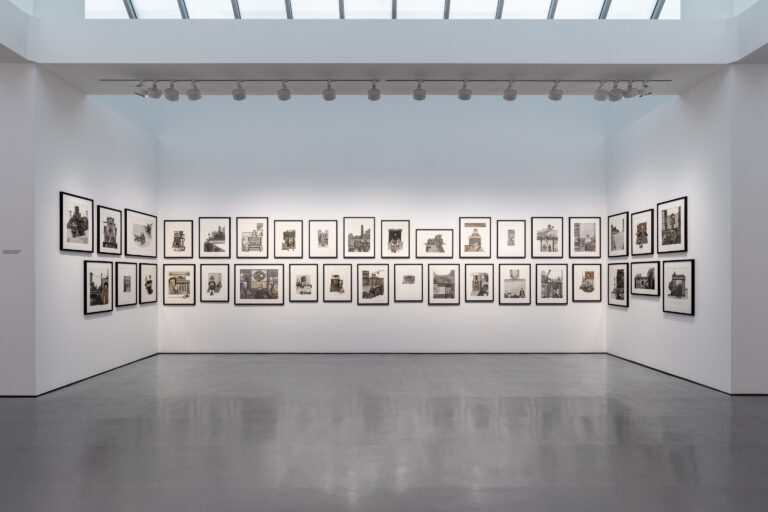
Exhibition view: Elisabeth Schrader, Lieber woanders,
Esther Schipper, Berlin, 2025
Courtesy the artist and Esther Schipper, Berlin/Paris/Seoul
Photo © CHROMA
Esther Schipper is pleased to announce Lieber woanders, an exhibition by Elisabeth Schrader. On view will be works on paper spanning the years 2005-2013.
The world we encounter in Elisabeth Schrader’s drawings is both strange and familiar. Crocheted blankets, carpets, wall paneling, or tiled floors, their intricate pattern dense and sometimes slightly claustrophobic, circumscribe spaces that can feel domestic and fantastic. These interiors are depicted in fragments, some blend the outside and inside, as if entire rooms had been transported into the street; some are reminiscent of doll houses whose roof is removed so we may can look into them. The figures—men, women, sometimes children, often animals—seem arrested in a timeless space, caught in a temporal vacuum. Yet, there is an intensity: they appear engaged in a watchful state of examining the world around them, intensely focused on their activities, and deep in thought. And many are looking back at us.
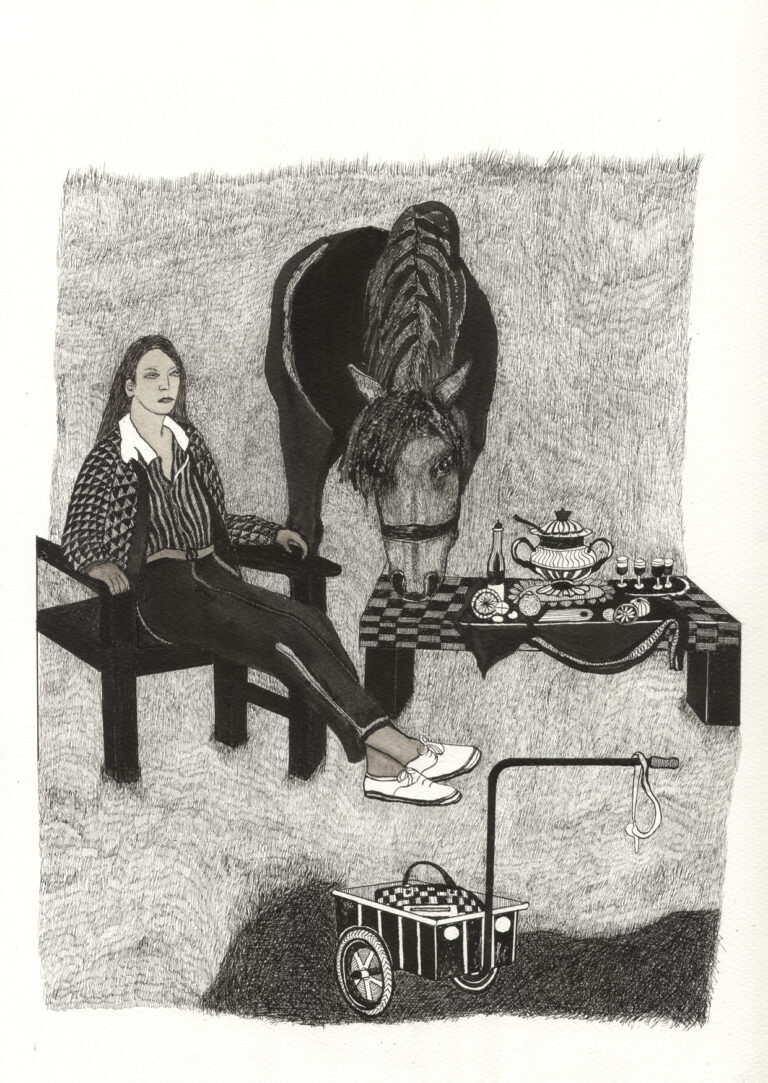
Elisabeth Schrader, Tee ist fertig, 2008,
india ink on paper, 45,4 x 30,5 cm (17 7/8 x 12 in)
(unframed) (ESC 029)
© the artist
For Schrader, similar to other artist’s of her generation, in the middle of her life other roles—as wife, mother, and daughter—took precedent. This experience makes itself present in the drawings in mood and sentiment but also in the frequency of domestic motifs. Her drawings create an idiosyncratic alternative world full of coffee pots, teasets, set tables, chairs and sofas that loom large. As the exhibition’s title suggests, an ongoing theme of the drawings is an intensely felt interiority: imagining a life beyond the confines of these rooms. One senses in these closely observed scenarios an impulse to liberate oneself from these interior’s restrained and with it from the smallness of bourgeois society. Dreaming herself away from drudgery and claustrophobia, Schrader uses humor as mitigating influence: her titles add a layer of dry humor that softens the sting—or deliver it.
Schrader’s prolific and original output is unadulterated by outside influences. There surely was a steady dialogue with her husband, Hinnerk Schrader who was also an artist and who sometimes prepared the grounds of her drawings, that sustained both. Thus one finds traces of her partner’s sustained exploration of the work of Goya in Elisabeth’s style. Executed in black and sepia-colored ink, the densely patterned surfaces and muted palette have a quality of etchings. And the Spanish artist’s sense of the simultaneity of the grotesque and comical, of farce and tragedy, echoes through her drawings of estranged domesticity with their incongruous assemblies of woman, man, pet or beast. There are also her own constant looking, searching and learning. Going to museums, amassing a library of catalogues, collecting materials for her objects during her vacations, photographing her surroundings during trips and excursions. Her lifelong fascination with Egyptian, art for example, is noticeable in the patterning of all surfaces and their frieze-like stillness and two-dimensionality, especially in the rendering of the figures. The faces—human and non-human—have a directnesss and a monumentality that is reminiscent of the figures in those enigmatic ancient friezes.
Elisabeth Schrader has an extensive oeuvre of drawings, sculptures, installation and assemblage which she worked on throughout her life. Born 1935 in Barcelona, she went to art school and studied first in Hanover and then Kassel (with Fritz Winter), getting a degree in art education. Married to a fellow artist, Hinnerk Schrader, who also taught art at high school, family life centered on the arts, frequently traveling to museums both near their home close to Hanover and throughout Europe. Even as both worked as teachers, both continued to practice as artists with an earnest seriousness and fury. For Elisabeth Schrader caring full-time for her three daughters, and her six-year work on a catalogue raisonne of her husband’s work after his early death in 1989, interrupted the steady production. After her early retirement from teaching in 1995, another period of intense focus on her work commenced. Now 90 years old, Elisabeth Schrader has produced an impressive and many-faceted life’s work.
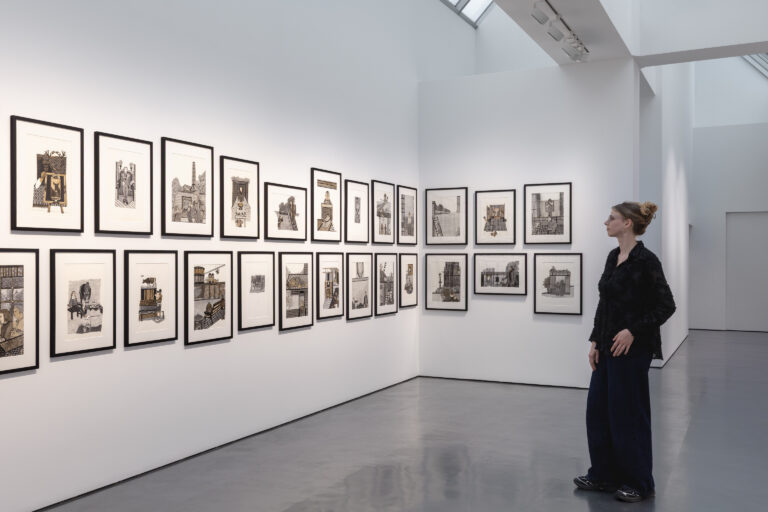
Exhibition view: Elisabeth Schrader, Lieber woanders,
Esther Schipper, Berlin, 2025
Courtesy the artist and Esther Schipper, Berlin/Paris/Seoul
Photo © CHROMA
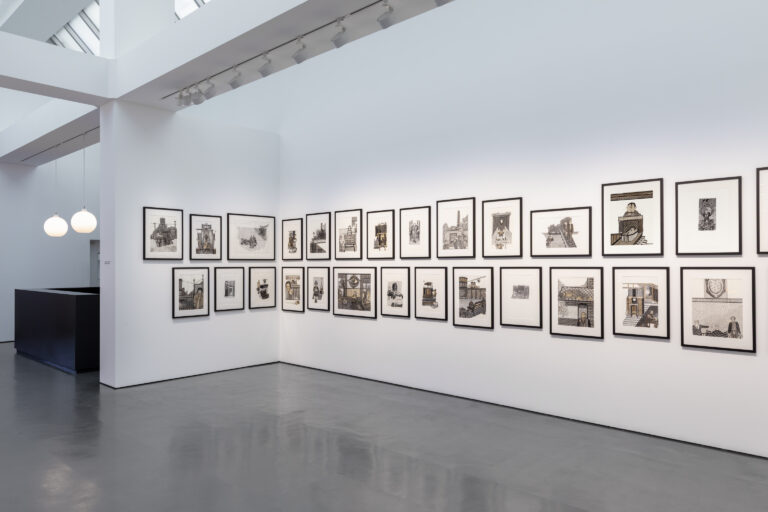
Exhibition view: Elisabeth Schrader, Lieber woanders,
Esther Schipper, Berlin, 2025
Courtesy the artist and Esther Schipper, Berlin/Paris/Seoul
Photo © CHROMA
Among the artist’s past exhibitions are: Elisabeth Schrader, vager Raum, kuratiert von Frank Hauschildt, SteDi Stiftung, Berlin (2025); Tomi Ungerer, femmes fatales, Annex der Ausstellung im Musée Tomi Ungerer – Centre international de l’illustration, Strasbourg (2014); Elisabeth Schrader, Freunde und Vollidioten, Amis et triples idiots, Atelier und Galerie Wittersdorf (2013); Es war einmal — wie es nie gewesen ist, Galerie Ute Parduhn, Düsseldorf (2012); Elisabeth Schrader, Hinnerk Schrader: Wie es ist, Schloss Landestrost, Neustadt (2010); 1. Internationalen Push-Art Berlin, Volksbühne am Rosa-Luxemburg-Platz, Berlin (2007); Elisabeth Schrader, Gehäkelte Objekte, Hermannshof, Völksen (2002); Elisabeth Schrader, Terracotta und Keramik, Galerie Hubert, Schwarmstedt (1989); Elisabeth Schrader, Hinnerk Schrader, Galerie Riedel, Schwarmstedt (1978).
